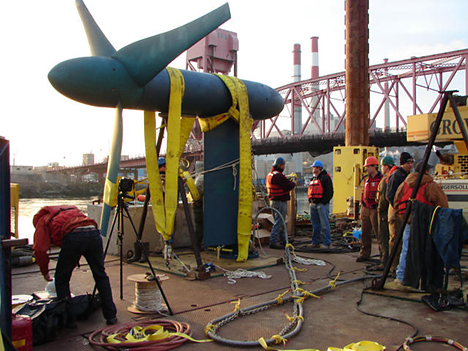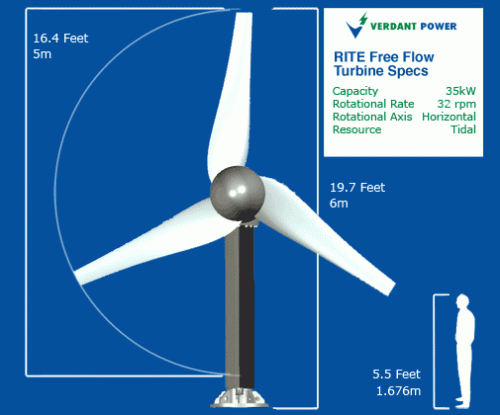As a green NY builder we are very interested the possibility of harnessing the massive tidal energy that surrounds Manhattan. The Roosevelt Island Tidal Energy (RITE) program began in 2002 with the goal of building an underwater tidal farm. Four years later in 2006 the installation of the first full scale (5m diameter rotor) turbine was planted into the East river.
 This became the world’s first grid connected array of tidal turbines. Benefits of this underwater farm are that they are, well, underwater, thus avoiding the visual issues associated with massive wind turbines or black rows of solar panels.
This became the world’s first grid connected array of tidal turbines. Benefits of this underwater farm are that they are, well, underwater, thus avoiding the visual issues associated with massive wind turbines or black rows of solar panels.
Tidal power is predictable and reliable, flowing with the everyday force of the moon moving water in and out of the East river. Because the East river is next to underground transmission lines, the turbine generated power could easily be plugged into the existing power grid, allowing for the tidal energy to be sent directly to customers.
The density of the water is greater than air which means that fewer turbines are necessary to produce the same amount of electricity as wind turbines at a higher rotational velocity. If the project is successful, the East river could host 300 turbines, providing 10 MW of renewable energy for the city, enough to power up to 8,000 homes.
That power could displace the equivalent of 68,000 barrels of oil, or 430 million cubic feet of natural gas per year. Like all renewable energy, it isn’t the solution in itself but is part of a solution where energy comes from many local sustainable sources instead of it all coming from oil.
 Another benefit to this power source is that it is an on-site power generation source, unlike coal power plants which are built away from cities to prevent their heavy air pollution from affecting the population. Along with the coal plant’s expensive transmission lines and relay stations needed in order to deliver the electricity to where it is needed, the total farm is an attractive part of the solution.
Another benefit to this power source is that it is an on-site power generation source, unlike coal power plants which are built away from cities to prevent their heavy air pollution from affecting the population. Along with the coal plant’s expensive transmission lines and relay stations needed in order to deliver the electricity to where it is needed, the total farm is an attractive part of the solution.
Conversely tidal turbines will enable the city to obtain a distributed energy source. Distributed energy systems generate power on a small scale ranging from 3 kW to 10,000 kW, the usual problem with this is that these generators are expensive. However the city will reclaim the cost of these generators by energy savings in just a few years.
Now the city will have the capability of generating power close to if not in the same building it will be used. The effect of this will be the revenue saved by not having to build and maintain transmission lines and relay stations. In addition these renewable sources will easily be able to integrate into Con Edison’s future smart grid.
We are excited to see this project progress. It makes a lot of sense on many levels. The size of this project is much larger than the sustainable jobs Eco Brooklyn does, since we typically work on residential brownstones. The idea is that all green builders, large or small, help build decentralized energy infrastructures in their own area, some large enough to feed a whole town, others so small they feed a fish pond. But added together they create an intelligent grid of energy that isn’t too big to fail or dependant on one centralized source.
Check out this short video about the project
Saf K.
